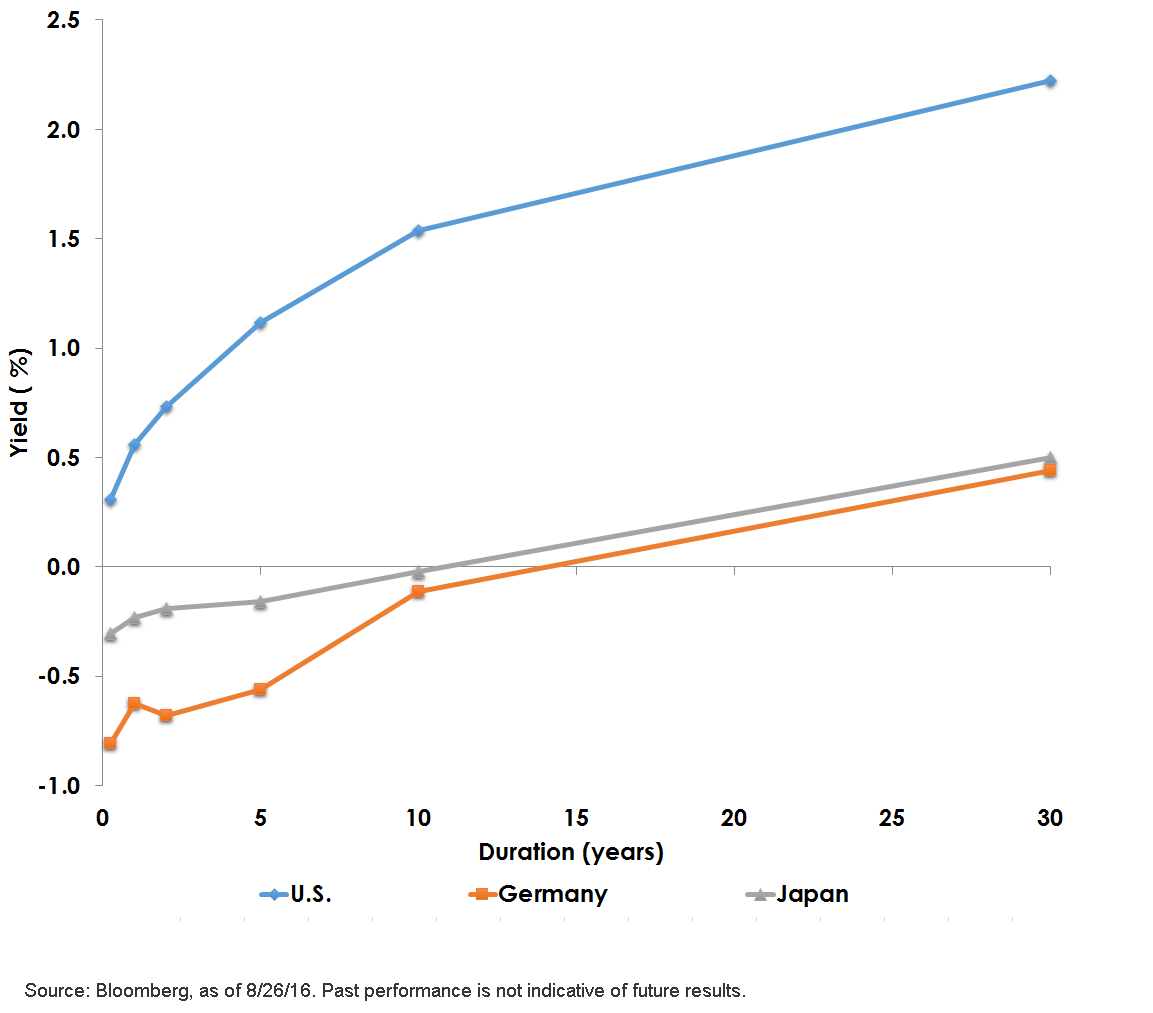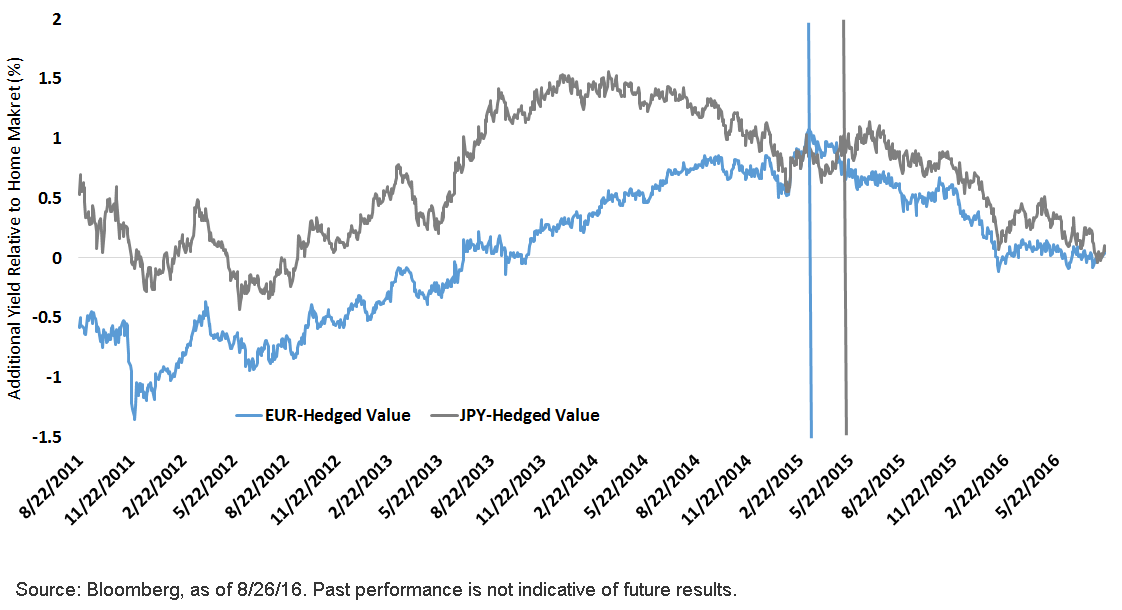Is Foreign Demand for U.S. Bonds Nearing Its Limit?


 In a prior post on emerging markets, we explained how yield is just a starting point for foreign currency denominated fixed income. While yields abroad may appear compelling, currency risk has the potential to have a much more significant impact on total return.
Above, we compare the U.S. Treasury yield curve versus Japanese and German government debt. Today, government bond yields in Japan and Europe are negative through 10-year maturities.1 While U.S. yields remain low by historical standards, they appear extremely generous compared to Europe and Japan.
In fact, the U.S. 10-Year bond offers a 163 basis points (bps) pickup in yield over the German 10-year and a 162-bps pickup against the Japanese 10-year. However, nominal yields are just a starting point. In order for foreign investors to take advantage of this income premium, they must expose themselves to U.S. dollar risk (and volatility). For this reason, a simple comparison between foreign interest rates and the U.S. can often be misleading, in our view.
U.S. 10-Year: Back to Reality
So how does the U.S. 10-Year compare to Japanese and German debt if investors hedged their positions back into euros or yen? As we show in the chart below2, a once-profitable trade may be reaching its limit. To calculate the potential advantage for European and Japanese investors to buy U.S. Treasuries, we compare the yield on their local debt versus the yield on a U.S. 10-Year Treasury that’s combined with a cross-currency basis swap.
Swapped Yield Comparison for European and Japanese Investors
Yield Advantage: EUR & JPY-Hedged U.S. 10-Year Treasury
In a prior post on emerging markets, we explained how yield is just a starting point for foreign currency denominated fixed income. While yields abroad may appear compelling, currency risk has the potential to have a much more significant impact on total return.
Above, we compare the U.S. Treasury yield curve versus Japanese and German government debt. Today, government bond yields in Japan and Europe are negative through 10-year maturities.1 While U.S. yields remain low by historical standards, they appear extremely generous compared to Europe and Japan.
In fact, the U.S. 10-Year bond offers a 163 basis points (bps) pickup in yield over the German 10-year and a 162-bps pickup against the Japanese 10-year. However, nominal yields are just a starting point. In order for foreign investors to take advantage of this income premium, they must expose themselves to U.S. dollar risk (and volatility). For this reason, a simple comparison between foreign interest rates and the U.S. can often be misleading, in our view.
U.S. 10-Year: Back to Reality
So how does the U.S. 10-Year compare to Japanese and German debt if investors hedged their positions back into euros or yen? As we show in the chart below2, a once-profitable trade may be reaching its limit. To calculate the potential advantage for European and Japanese investors to buy U.S. Treasuries, we compare the yield on their local debt versus the yield on a U.S. 10-Year Treasury that’s combined with a cross-currency basis swap.
Swapped Yield Comparison for European and Japanese Investors
Yield Advantage: EUR & JPY-Hedged U.S. 10-Year Treasury
 In this hypothetical, foreign investors are not exposed to foreign currency risk and minimal relative interest rate risk. Five years ago, when European short-term interest rates were higher than U.S. rates, German investors would have sacrificed income by investing in U.S. Treasuries and hedging back into euros. However, after the so-called “taper-tantrum” in May 2013, investors in Germany and Japan could capture a reasonable pickup in yield by owning U.S. debt and hedging. With central banks abroad embarking on asset purchases and U.S. investors decreasing positions in U.S. fixed income investments in anticipation of a Fed rate hike, the relative advantage continued to grow.
In a separate but seemingly related phenomenon, the value of the U.S. dollar continued to appreciate against the Japanese yen and euro over this period because of rising rate differentials. By owning U.S. debt unhedged, Japanese and European investors were potentially able to boost total returns by collecting higher income and gaining from U.S. dollar strength.
Interestingly, the chart above also highlights the point at which the U.S. dollar peaked versus both the yen and the euro. Subsequently, the advantage of owning U.S. fixed income investments relative to domestic markets begins to decline. It is likely that investors who had previously owned U.S. fixed income unhedged began to hedge their U.S. dollars back to the Japanese yen and euros. As a result, demand for hedging these positions started to rise, thus negating the advantage of swapping U.S. debt. At the same time, short-term U.S. interest rates began to rise as a result of money market reform, which added further pressure to this trade. The dollar weakened because foreign investors sold U.S. dollars and bought their local currency.
U.S. Yield Advantage Dissipates
Today, the advantage of owning U.S. debt on a currency-hedged basis is virtually nonexistent. Put another way, the potential arbitrage for foreign investors is gone, which could dampen U.S. fixed income flows. As a result, U.S. rates may increasingly be determined by domestic factors such as Fed policy and the outlook for inflation vs. global demand. Additionally, with the potential for risk-free return diminished for foreign investors, some may be more willing to take on currency risk to boost returns. Should these current hedges roll off, we may be poised to enter another period of U.S. dollar strength, especially as the Fed hikes interest rates and raises the costs to hedge U.S. dollars further.
1Source: Bloomberg, as of 8/26/16.
2The yield series below are calculated by combining the 10-year U.S. Treasury yield + (Foreign 3m LIBOR –U.S. 3m LIBOR) + Foreign 10-year basis swap compared to the local bond yield.
In this hypothetical, foreign investors are not exposed to foreign currency risk and minimal relative interest rate risk. Five years ago, when European short-term interest rates were higher than U.S. rates, German investors would have sacrificed income by investing in U.S. Treasuries and hedging back into euros. However, after the so-called “taper-tantrum” in May 2013, investors in Germany and Japan could capture a reasonable pickup in yield by owning U.S. debt and hedging. With central banks abroad embarking on asset purchases and U.S. investors decreasing positions in U.S. fixed income investments in anticipation of a Fed rate hike, the relative advantage continued to grow.
In a separate but seemingly related phenomenon, the value of the U.S. dollar continued to appreciate against the Japanese yen and euro over this period because of rising rate differentials. By owning U.S. debt unhedged, Japanese and European investors were potentially able to boost total returns by collecting higher income and gaining from U.S. dollar strength.
Interestingly, the chart above also highlights the point at which the U.S. dollar peaked versus both the yen and the euro. Subsequently, the advantage of owning U.S. fixed income investments relative to domestic markets begins to decline. It is likely that investors who had previously owned U.S. fixed income unhedged began to hedge their U.S. dollars back to the Japanese yen and euros. As a result, demand for hedging these positions started to rise, thus negating the advantage of swapping U.S. debt. At the same time, short-term U.S. interest rates began to rise as a result of money market reform, which added further pressure to this trade. The dollar weakened because foreign investors sold U.S. dollars and bought their local currency.
U.S. Yield Advantage Dissipates
Today, the advantage of owning U.S. debt on a currency-hedged basis is virtually nonexistent. Put another way, the potential arbitrage for foreign investors is gone, which could dampen U.S. fixed income flows. As a result, U.S. rates may increasingly be determined by domestic factors such as Fed policy and the outlook for inflation vs. global demand. Additionally, with the potential for risk-free return diminished for foreign investors, some may be more willing to take on currency risk to boost returns. Should these current hedges roll off, we may be poised to enter another period of U.S. dollar strength, especially as the Fed hikes interest rates and raises the costs to hedge U.S. dollars further.
1Source: Bloomberg, as of 8/26/16.
2The yield series below are calculated by combining the 10-year U.S. Treasury yield + (Foreign 3m LIBOR –U.S. 3m LIBOR) + Foreign 10-year basis swap compared to the local bond yield.
Important Risks Related to this Article
Fixed income investments are subject to interest rate risk; their value will normally decline as interest rates rise. In addition, when interest rates fall, income may decline. Fixed income investments are also subject to credit risk, the risk that the issuer of a bond will fail to pay interest and principal in a timely manner or that negative perceptions of the issuer’s ability to make such payments will cause the price of that bond to decline.


